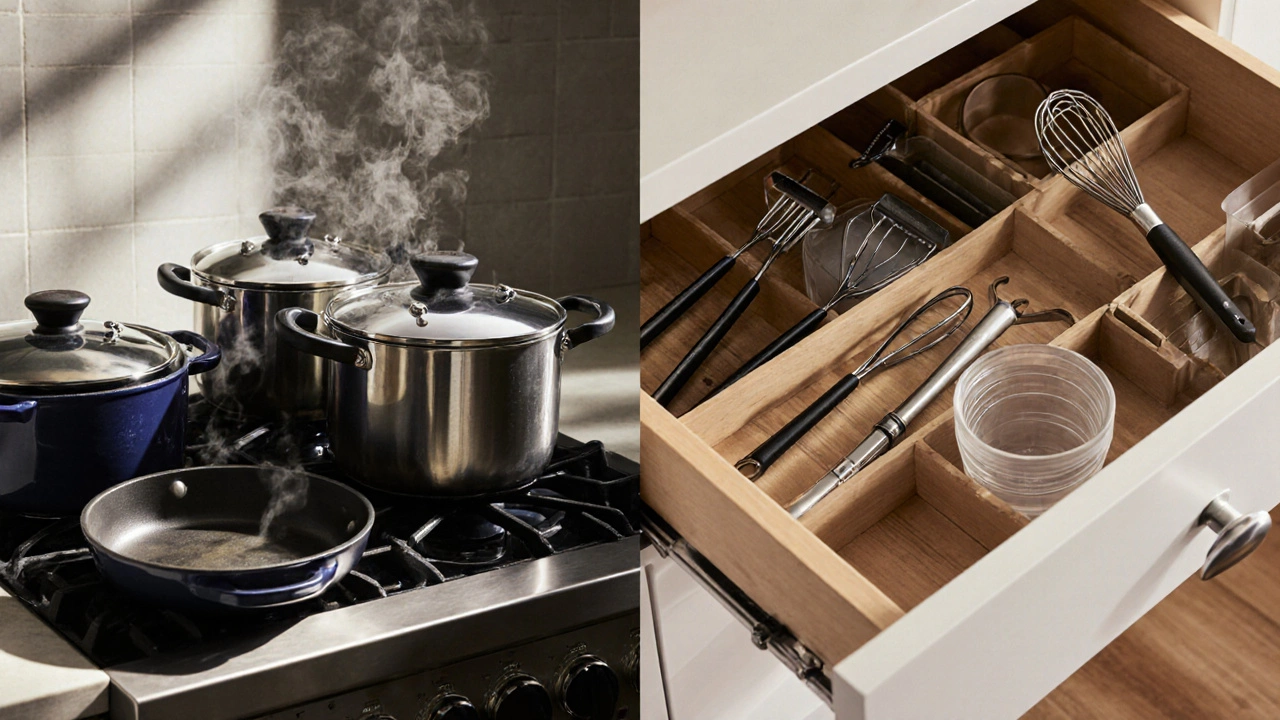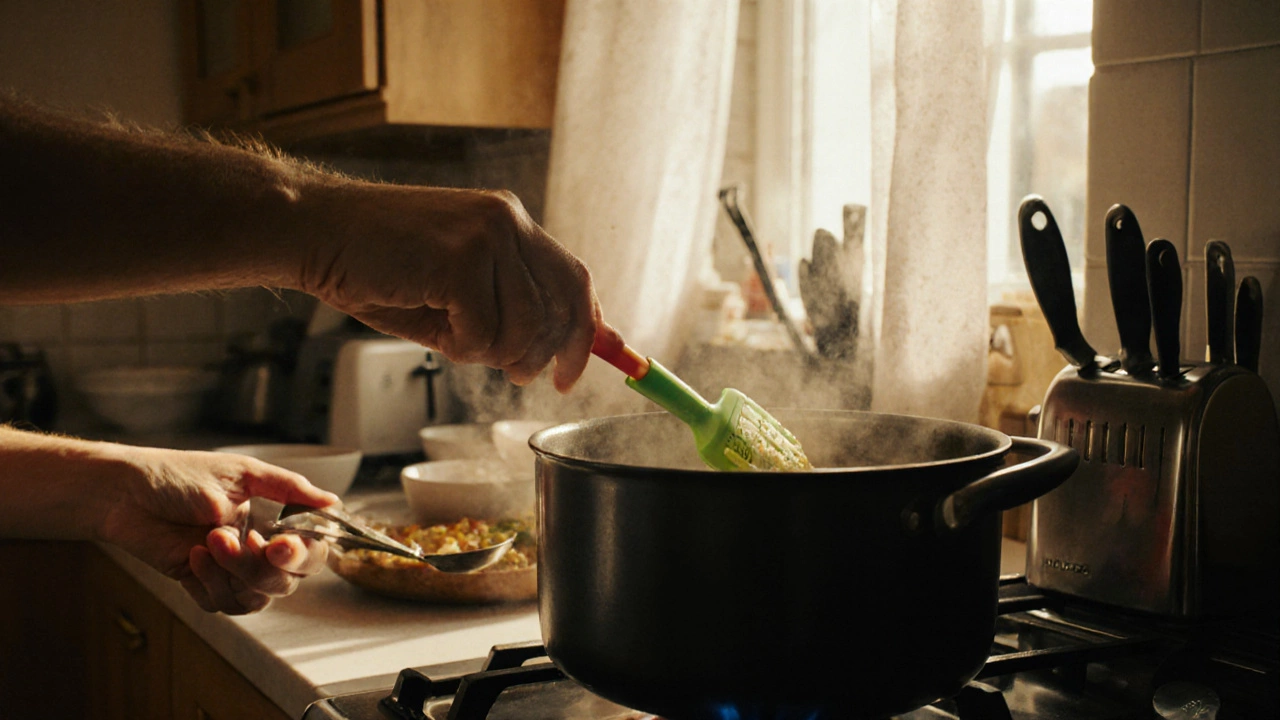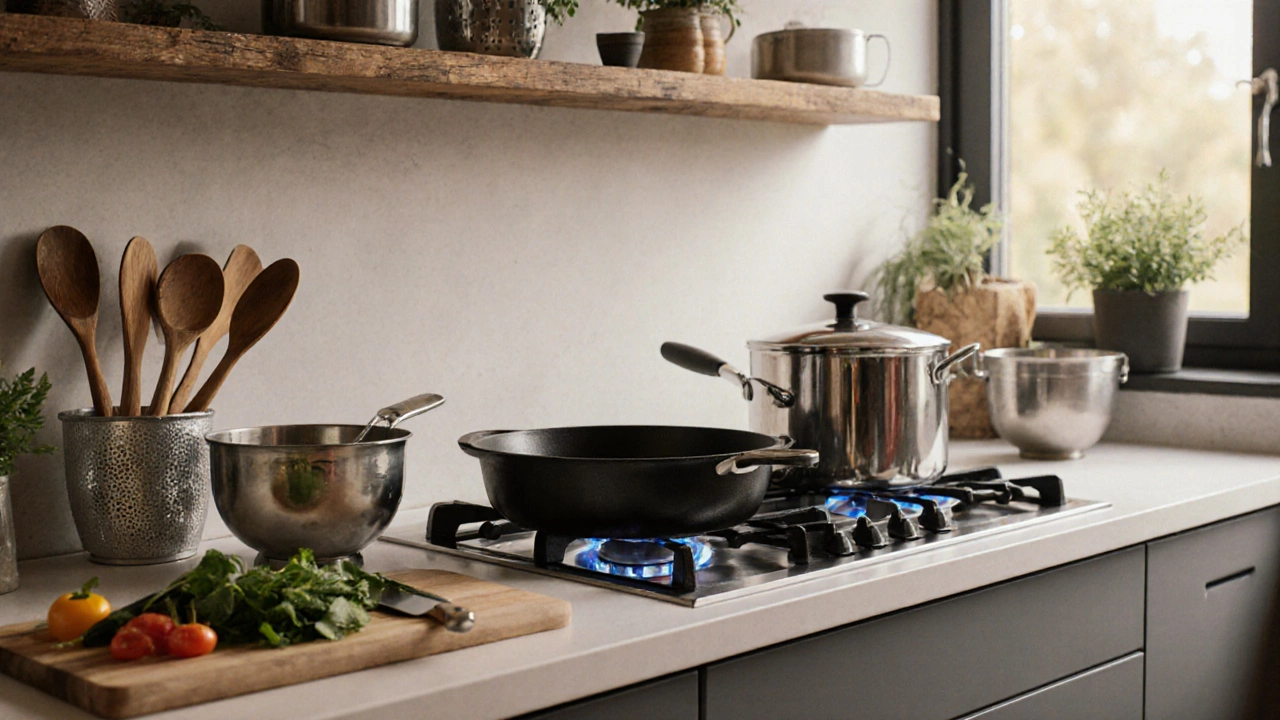Ever bought a spatula and called it cookware-only to realize later it doesn’t belong in the same category as your Dutch oven? You’re not alone. Most people use kitchenware and cookware interchangeably, but they’re not the same. Mixing them up won’t ruin your meal, but knowing the difference helps you shop smarter, organize better, and avoid buying the wrong thing by accident.
Kitchenware is everything you use in the kitchen
Kitchenware covers every single tool, gadget, and item you handle while preparing, serving, or storing food. It’s the broad category that includes everything from your cheese grater to your napkin holder. Think of it as the entire toolkit of your kitchen, not just the parts that touch heat.
Examples of kitchenware include:
- Measuring cups and spoons
- Can openers
- Colanders and strainers
- Whisks, peelers, and zesters
- Cutting boards and knives
- Food storage containers
- Utensils like tongs, ladles, and slotted spoons
- Tableware like plates, bowls, and glasses
- Appliances like blenders, toasters, and coffee makers
None of these need to go on the stove. A wooden spoon? Kitchenware. A silicone baking mat? Kitchenware. Even your fridge’s vegetable drawer counts as kitchenware-it’s part of how you manage food in your kitchen.
Cookware is what goes on the heat
Cookware is a subset of kitchenware. It’s specifically the pots, pans, and vessels designed to hold food while it’s being cooked on a stove, oven, or open flame. These items are built to handle high temperatures, conduct heat evenly, and often come with lids or handles made to stay cool.
Examples of cookware include:
- Saucepans and stockpots
- Frying pans and skillets
- Dutch ovens
- Roasting pans
- Steamers and pressure cookers
- Woks
- Baking dishes (like glass or ceramic casserole dishes)
Notice anything? These are all things you put food into and then put on a heat source. A cast iron skillet? Cookware. A ceramic baking dish? Cookware. A stainless steel saucepan? Definitely cookware. They’re made from materials like stainless steel, cast iron, aluminum, or enameled ceramic-all chosen for heat resistance and durability.
Why the confusion happens
The overlap is real. Some items blur the line. A silicone spatula is kitchenware, but you use it with a frying pan-which is cookware. A wooden spoon? Kitchenware. But if you’re stirring soup in a pot, you’re using both together.
Another reason people mix them up? Retailers. Online stores often label everything as “cookware” because it sounds more appealing. You’ll see a set of mixing bowls listed under “cookware,” even though they’re never heated. That’s marketing, not accuracy.
It’s also cultural. In some households, “cookware” is just the catch-all term for anything in the kitchen. But if you’re trying to replace a worn-out pot or upgrade your frying pan, you need to know exactly what you’re looking for.

What you should buy-and when
If you’re setting up your first kitchen, start with cookware. You can’t cook without pots and pans. A good 10-inch skillet, a medium saucepan, and a large stockpot will cover 80% of daily meals. These are investments. Buy them well. Look for heavy bottoms, secure handles, and materials that distribute heat evenly-like clad stainless steel or seasoned cast iron.
Kitchenware, on the other hand, you can buy gradually. Start with the basics: a sharp knife, a cutting board, measuring tools, and a few utensils. You don’t need 12 different whisks or 5 colanders. Buy as you need them. A garlic press? Only get it if you use garlic often. A citrus zester? Skip it unless you bake.
Here’s a simple rule: If it touches heat, it’s cookware. If it doesn’t, it’s kitchenware. That’s your filter.
Materials matter more for cookware
Cookware materials directly affect how your food cooks. Aluminum heats fast but can warp. Stainless steel is durable but needs oil to prevent sticking. Cast iron holds heat like a champ but requires seasoning. Ceramic coatings are non-stick but chip over time.
Kitchenware materials? Less critical. A plastic spatula won’t melt if you’re careful. A bamboo cutting board is fine. A silicone spatula is heat-resistant up to 600°F, so it’s safe with cookware-but it’s still not cookware itself.
One exception: metal utensils. If you use them with non-stick cookware, you scratch the surface. So even though a metal spatula is kitchenware, you need to match it to your cookware type. That’s where knowledge saves your pan.

Storage and organization
Knowing the difference helps you organize better. Store cookware where you use it-near the stove. Hang your pots and pans. Stack them with care to avoid scratches. Keep kitchenware in drawers or cabinets near prep areas: knives next to the cutting board, measuring cups near the flour bin.
When you shop, you’ll stop buying “cookware” sets that include serving spoons and tongs. Those belong in kitchenware. You’ll save money by buying only what you need. A 5-piece cookware set with matching lids? Great. A 20-piece “kitchen set” that includes a bottle opener and a salad spinner? Probably overkill.
Real-life example: Sunday brunch
Let’s say you’re making pancakes. You grab a non-stick frying pan-cookware. You pour batter from a measuring cup-kitchenware. You flip them with a silicone spatula-kitchenware. You serve them on plates-kitchenware. You warm syrup in a small saucepan-cookware. You wipe the counter with a towel-kitchenware.
Every item has a role. Only two of them were heated. That’s the difference.
What to do next
Look around your kitchen right now. Grab three items. Ask: Did this item ever touch a stove, oven, or flame? If yes-it’s cookware. If no-it’s kitchenware. You’ll be surprised how clear it becomes.
When you shop next, don’t just click “cookware.” Filter for “pots and pans.” Look for “kitchen tools” when you need a grater or a peeler. Use the right terms, and you’ll find exactly what you need-faster, cheaper, and without regret.
Is a baking sheet cookware or kitchenware?
A baking sheet is cookware because it goes directly into the oven to cook food. Even though it’s flat and doesn’t hold liquid, it’s designed to transfer heat to what’s on it-like cookies, roasted veggies, or chicken. That makes it cookware, not just a tray.
Can kitchenware be made of the same materials as cookware?
Yes, but their function changes the category. A stainless steel whisk is kitchenware, even though it’s made of the same metal as a saucepan. The whisk doesn’t hold food over heat-it just stirs. The saucepan does. Material alone doesn’t define the category; use does.
Do I need to buy cookware and kitchenware sets?
No. Sets are marketing. You’ll end up with tools you never use. Buy cookware based on your cooking habits: if you make soups often, get a good stockpot. If you fry eggs daily, get a solid skillet. For kitchenware, buy one quality knife, a few basic utensils, and add more only when you find yourself wishing you had them.
Is a microwave considered cookware or kitchenware?
A microwave is kitchenware. It’s an appliance that heats food, but it doesn’t hold the food during cooking-the dish inside does. The plate or bowl you put food in? If it’s microwave-safe, it’s cookware. The microwave itself? Kitchenware, because it’s the machine you use to operate the process.
What about silicone molds for baking? Are they cookware?
Yes. Silicone molds go into the oven to bake cakes, muffins, or chocolates. Even though they’re flexible and non-metal, they’re designed to hold food during cooking. That makes them cookware. The same mold used to freeze ice cubes? Then it’s kitchenware.
Once you get this right, your kitchen will feel less chaotic. You’ll know what to replace, what to upgrade, and what to skip. And when someone asks you what’s the difference between kitchenware and cookware-you’ll be the one who actually knows.



